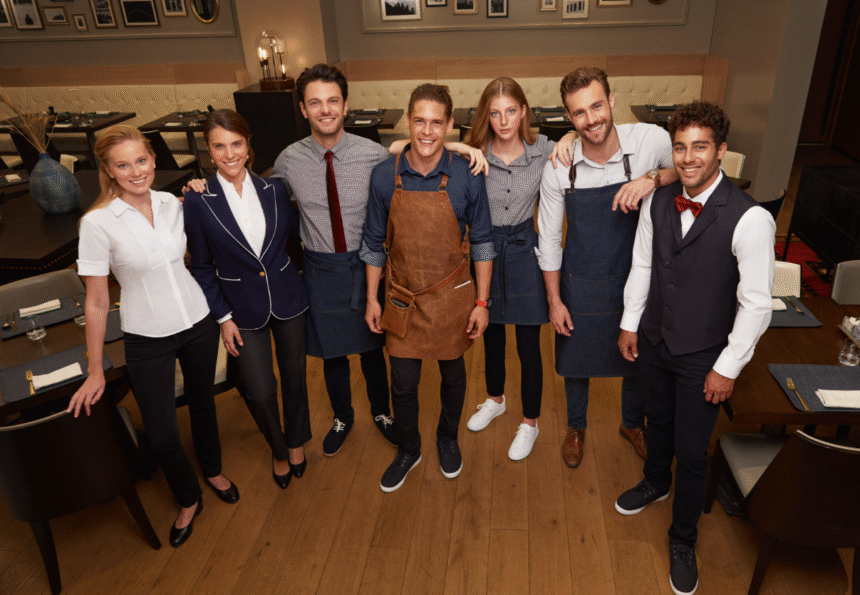In the hotel industry, well-designed staff uniforms are key to creating a professional image. We are told not to judge a book by its cover, but the truth is, the cover sets the expectation of the story inside. From the moment a guest walks in, every detail sets the tone for their stay. A polished uniform sends a strong message of professionalism and gives the guest confidence that they’ve chosen the right place.
But great hotel staff uniforms aren’t just about looks. They need to be comfortable, practical and durable and reflect the hotel’s brand. And because every department has a different role, each has its uniform requirements.
Front Desk
When choosing hotel uniforms for the front desk staff, the goal is to get the balance right between elegance, professionalism and comfort.
Receptionists are the first people guests see when they arrive, so their attire should make a strong positive impression. In most hotels, this means formal suits or dresses: for men, a jacket, shirt, tie and classic trousers; for women, a skirt or trousers with a matching jacket. Luxury hotels with a more traditional style may go for something even more refined, like morning coats, stroller jackets or frock coats, which evoke a timeless old-world charm.
Whatever the style, the key is to keep it polished but not flashy. Even with modern hotel staff uniforms, designs should be tasteful and professional but still reflect current trends. Slim fit, narrower shoulders and tailored trousers have become popular choices offering a sharp modern silhouette without losing formality.
When it comes to colour, understated is best. Deep blue, grey and black are classics and convey authority and seriousness, with lighter tones used in summer. Some global hotel chains experiment with brighter colours, but most prefer a sophisticated neutral palette.
Material choice is important. Because receptionists work indoors in air-conditioned environments (except for some resorts), fabrics should be durable yet comfortable for long hours of wear. Lightweight wool or blends of wool and synthetic fibres are ideal as they hold their shape, resist wear and feel comfortable all day.
Housekeeping
For housekeeping staff, practicality is key. Housekeepers are always on the move, making beds, cleaning floors and tidying rooms. So they need uniforms that allow freedom of movement without feeling heavy or restrictive. But practicality shouldn’t mean sacrificing style. Housekeeping staff are part of the hotel’s image, and their appearance should reflect professionalism, order and cleanliness.
In higher-end hotels, the classic choice is a fitted dress or a comfortable coat with a matching apron, often more decorative than functional. These can have or not have a collar and short or three-quarter sleeves. In more casual or budget hotels, poncho-style aprons are popular for their simplicity and ease of wear. Many modern hotels are now switching to tunic and trouser sets, which offer more flexibility and comfort and are a favourite among housekeeping teams.
Colour choices should match the style and category of the hotel. Luxury hotels go for neutral, understated tones, while brighter colours are more common in resorts and holiday villages. Some 5-star hotels also reserve black uniforms for turndown service, although in some places, black is worn for daily cleaning as well.
As housekeeping involves frequent contact with cleaning chemicals, durable fabrics are a must. Cotton is breathable and hypoallergenic, but more expensive and less resistant to wear. Cotton polyester blends (50/50) offer a good balance of comfort and durability, while polycotton (65% polyester, 35% cotton) is more budget-friendly and highly resistant to frequent washing.
Restaurant and Banquet
Restaurant and banquet staff need uniforms that work as hard as they do – practical enough to handle a busy service yet stylish enough to match the hotel’s dining atmosphere. Common elements include server vests, aprons, bow ties and formal shirts, which together give a refined, cohesive look.
Hygiene is key in any dining environment, so uniforms should be made from easy-to-clean, durable fabrics that can withstand frequent washing while maintaining their shape and colour. Popular choices include polyester cotton blends, which balance comfort with resilience and materials treated for stain resistance to keep staff looking fresh throughout service.
Colour-wise wise choose tones that match the hotel’s brand and dining environment. Luxury and fine dining go for classic, elegant colours like black, navy, charcoal, sometimes with gold, silver or white for a touch of sophistication. Casual dining can have warmer or brighter colours to create a relaxed ambience.
Kitchen Staff
Working in a hot and fast-paced environment means the right uniform can make all the difference, not just for appearance but for protection and performance. Standard kitchen uniforms include chef coats, pants, hats and non-slip shoes, each playing a role in keeping staff safe, hygienic and looking professional.
Chef coats act as a barrier against heat, steam and spills, kitchen pants provide flexibility for constant movement, chef hats or caps keep hair contained, supporting hygiene standards and non-slip shoes prevent accidents on wet or greasy floors.
Fabric choice is key. Materials should be able to withstand high heat and frequent washing without losing shape or colour. Cotton is breathable and comfortable, great for hot kitchens, but it can shrink or wear out faster. Cotton polyester blends are a good compromise, combining comfort with durability, while heavy-duty polycotton fabrics provide extra resistance to stains and wear. Stain-resistant treatments are also worth considering to keep uniforms looking fresh during long shifts.
Colours should balance practicality with the image the hotel wants to project. White is still a favourite for chef coats as it conveys cleanliness and professionalism, and can be bleached to remove stains. But darker shades like black or charcoal are becoming popular in some kitchens for their modern look and ability to hide marks during shifts.
Final Words
By considering these points, you’ll be well on your way to choosing the right uniforms for your hotel staff. It’s also a good idea to involve your team in the design process. Ask for their feedback. This will not only help you create uniforms that work in real-world conditions but also make your staff feel valued and confident in what they wear. After all, they are the ones who will be wearing the uniforms, and their opinions can make a big difference in how well the uniforms are accepted and worn with confidence.















